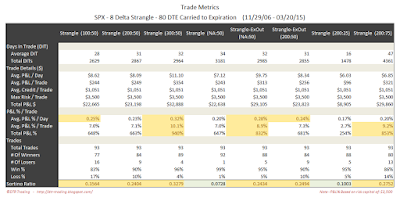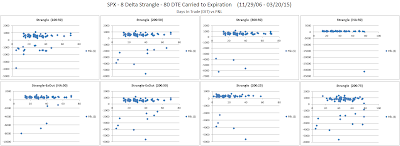For background on the setup for the backtests, as well as the nomenclature used in the charts and tables below, please see the introductory article for this series: Option Strangle Series - Higher Loss Thresholds
In the trade metrics tables, I have highlighted some of the metrics rows to indicate values that are in the upper half of the readings. One of the metrics to note is the average P&L per day in percentage terms (Trade Details (%) - Avg. P&L / Day). This is a measure of the P&L per day normalized to the maximum initial portfolio margin (initial PM) required for that trade run...it tells us the effectiveness of theta with respect to our margin requirement.
Also note, that all of the blog posts for the SPX strangle series have equity curves with identical y-axis scales.
4 Delta Short Strikes
 |
| (click to enlarge) |
 |
| (click to enlarge) |
6 Delta Short Strikes
 |
| (click to enlarge) |
 |
| (click to enlarge) |
8 Delta Short Strikes
 |
| (click to enlarge) |
 |
| (click to enlarge) |
With the 80 DTE tests, the highest average P&L per day reading occurred with the 8 delta short strike variation, with an average of 0.24% per day. The highest overall P&L per day readings occurred with the 8 delta 300:50 variation, at 0.32% per day.
Below are three images of scatter plots for the 80 DTE 8 delta short strangles. The first image contains one scatter plot per strategy and shows P&L in dollar terms versus days-in-trade (DIT). There is one visible trend in this set of scatter plots: the largest losses tend to occur at lower DIT values for trades with a loss based exit.
 |
| (click to enlarge) |
The second image shows P&L in terms of the initial at-the-money (ATM) implied volatility (IV) of the SPX. This ATM IV was captured on the day each trade was initiated. In general, there is a trend that higher P&L numbers are associated with higher ATM IV numbers...similar to the 45 DTE scatter plots.
 |
| (click to enlarge) |
The last images shows P&L in terms of the initial IV Rank for the SPX. The IV Rank was captured on the day each trade was initiated. In general, there is a trend that higher IV rank is associated with higher P&L. Also, if you trade only when IV rank is higher, you can eliminate many losing trades. Both of these trends were visible in the 45 DTE scatter plots as well.
 |
| (click to enlarge) |
In the next post I will summarize the results for the SPX short strangle strategy.
FYI, I am showing the results for higher delta strangles (at the same DTEs), as well as 8 additional exits on my Twitter feed...I won't be posting these additional results to the blog.
You can follow my blog by email, RSS feed or Twitter. All options are free, and are available on the top of the right hand navigation column under the headings "Subscribe To RSS Feed", "Follow By Email", and "Twitter". I follow blogs by RSS using Feedly, but any RSS reader will work.
2 comments:
Hi, Dave:
First I like to thank you for sharing your test results. You really did an amazing job back testing, organizing and presenting the large amount of data.
I would like to know how do you calculate the max risk for strangle? Would the potential risk be much higher (unlimited in theory) than what is shown (e.g. $2500 for 4 delta 80 DTE)?
Also, is there a place to view or download the test result for each trade for DTE80? The reason I ask is that the summary data may be skewed by the loss in 2008. It would be nice to be able to analyze the data in different years w/wo extreme cases.
Thanks,
JoAnn
Hi, Dave:
I am not sure if my first try to comment went through. Here is a copy of my questions.
First I like to thank you for sharing your test results. You really did an amazing job back testing, organizing and presenting the large amount of data.
I would like to know how do you calculate the max risk for strangle? Would the potential risk be much higher (unlimited in theory) than what is shown (e.g. $2500 for 4 delta 80 DTE)?
Also, is there a place to view or download the test result for each trade for DTE80? The reason I ask is that the summary data may be skewed by the loss in 2008. It would be nice to be able to analyze the data in different years w/wo extreme cases.
Thanks,
JoAnn
Post a Comment